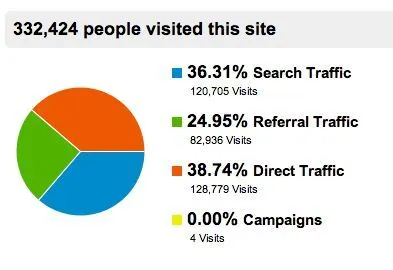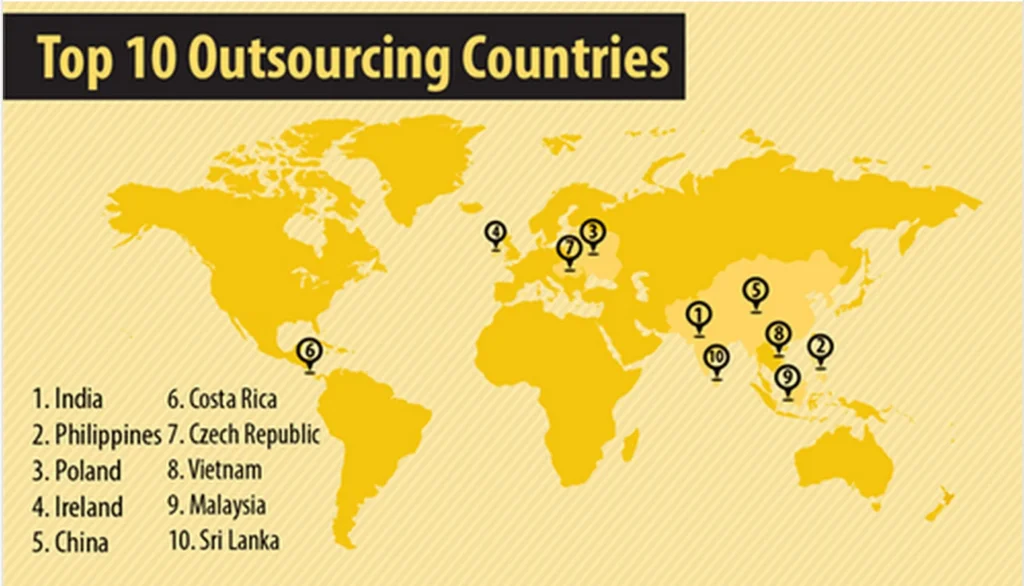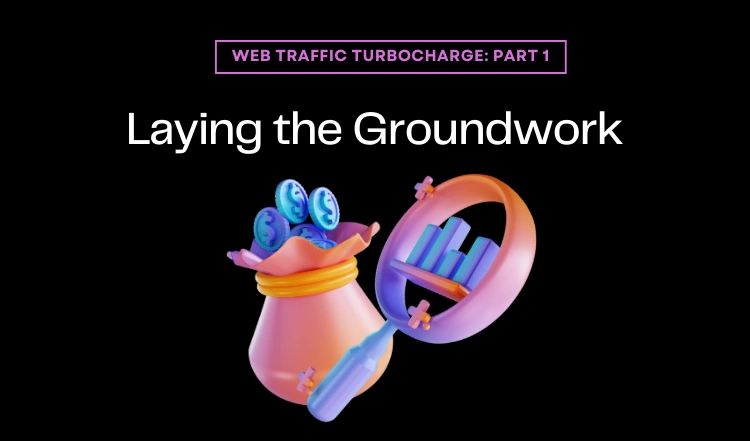Imagine your website as a fabulous party, complete with blaring music, dazzling lights, and a buffet table piled so high it could make Gordon Ramsay weak at the knees.
But here’s the catch: if nobody shows up to the party, it’s just you and a lonely bowl of guacamole.
Not exactly a rockin’ soirée, right?
That’s where traffic generation comes in. It’s the magical art of getting people to flock to your website like enthusiastic party goers in search of a good time.
But hold your horses, before we can dive into the nitty-gritty of traffic generation, we need to lay a rock-solid foundation. First, we’ll determine your aspirations because, let’s face it, even websites have dreams. Once we’ve set our sights on success, we’ll strategize how to attract your dream audience and lead them straight to your virtual doorstep.
I’ll also show you how to identify tasks to outsource, evaluate potential partners like a secret agent assessing recruits, utilize free and paid traffic generation, crush your conversion optimization, and master the art of wooing your audience while tracking the success of your traffic endeavors.
And that’s just the beginning, we’ll explore the unsung hero of traffic generation: content creation.
I’ll guide you in the tradecraft of high-quality content creation that captivates, educates, and leaves your audience begging for an encore.
So, buckle up, because we’re about to embark on an epic adventure through the realms of traffic generation!
The Importance of Traffic in Digital Marketing
You know the joy you feel when your post gets liked or shared, or when your blog has a new comment? That’s the magic of traffic in digital marketing. But it isn’t just about feeding your ego or giving you the warm fuzzies.
Traffic is the lifeblood of any online business, the non-stop party where you get to be the host.
Traffic increases the visibility of your brand, kind of like having your business on a busy street corner versus a remote back alley. More eyes on your content equals more opportunities for engagement, conversion, and ultimately, sales.
After all, if a website exists on the internet, but nobody visits it, does it really exist?
So, buckle up as we embark on a deep dive into the world of traffic, where you’ll learn about crafting strategies, creating engaging content, analyzing performance, and much more.
Remember, traffic generation is not a one-size-fits-all leather jacket. It’s more like a bespoke suit. It needs to fit your brand’s specific goals, audience, and resources. So, keep an open mind, think strategically, and always remember to have some fun along the way.
Putting Together a Successful Traffic Strategy in 4 Steps
Step 1: Determine Your Exact Aspirations
Let’s not kid ourselves. We’re all in this game to win. But to do that, we need to define what winning looks like. Just like Alice learned in Wonderland, “If you don’t know where you’re going, any road will get you there.“
Determining your aspirations means setting clear, actionable goals for your traffic strategy. These could be anything from increasing website visitors, boosting social media engagement, enhancing brand awareness, to the holy grail – sales conversions.
Before you roll your eyes and exclaim, “Not goals again!“, bear with me.
Goals give us a destination, a light at the end of the marketing tunnel. Without goals, we might as well be marketing in the dark. So, grab a cup of your favorite brew, sit in your most comfortable chair, and get down to some serious goal setting.
Don’t forget to make your goals Specific, Measurable, Achievable, Relevant, and Time-bound (SMART).
Understand your objectives clearly. What do you foresee for your business in terms of revenue and sales? Figure this out before you estimate the amount of traffic needed to achieve these objectives.
However, remember to ground your ambitions in reality. If your online marketing journey is in its infancy, envisioning a $10 million turnover this year might be stretching too far.
Instead, aiming for a $100,000 revenue (with the traffic required to get there) could be a more feasible target.
Next, start reverse-engineering the specific traffic and conversion metrics you need to achieve your revenue goal.
Ask yourself:
- What is your monthly revenue target? (Divide your yearly goal by 12)
- How much of your service or how many of your product do you need to sell to hit your monthly target? (Take into account both your primary and secondary offers)
- What’s the conversion rate for these offerings?
- Given this conversion rate, how much traffic is necessary to hit your targets?
You shouldn’t be pulling traffic goals out of thin air. Make sure your estimates are realistic, and to play safe, add an extra 20% to these estimates to account for any underestimation.
Step 2: Outline The Easiest Path To Success
Goals are awesome. They tell us where we’re going. But we also need to know how we’re going to get there. That’s where outlining your path to success comes in, you need a plan to meet your traffic goals.
This involves determining what actions you’ll take, what resources you’ll need, and how you’ll track your progress.
Think about which traffic sources make the most sense for your brand.
Will you focus on SEO?
Social media?
Paid ads?
Will you write epic blog posts or produce awe-inspiring videos?
Will you do it all yourself, or do you need to recruit some marketing professionals to help you?
And how will you know you’re on the right path?
By tracking metrics like website visitors, page views, likes, shares, and (let’s not forget) sales. The road to success may be winding, but with a clear plan, you can navigate it like a pro.

Step 3: Establish Your Traffic Goals
Now that you have your aspirations and a path to success, let’s put some numbers on those dreams. It’s time to set traffic goals.
These are quantifiable targets that keep your strategy focused and give you something to celebrate.
Traffic goals can be set for different stages of the buyer’s journey.
Maybe you want 10,000 new visitors to your site (awareness), or you want to increase your email sign-ups by 50% (consideration), or you aim to increase your conversion rate by 5% (decision).
The key is to align these goals with your broader business objectives.
But remember, traffic for the sake of traffic isn’t just about the number of people who visit your site but the quality of those visitors.
Are they your target audience?
Are they engaged?
Do they stick around, or do they bounce quickly?
So, when you set your traffic goals, think of quality as well as quantity.
Step 4: Plan Out Your Traffic Routes
You’ve got your destination, your roadmap, and your success metrics.
Now, it’s time to plan your traffic routes.
These are the channels through which you’ll attract and direct visitors to your site. You’ll need to know which routes are most effective and when to switch things up.
Will you use organic search, tapping into the power of SEO to attract visitors?
Or maybe social media is where your audience hangs out, so that’ll be a major route for you.
Don’t forget about email marketing, a tried-and-true way to drive traffic.
Or perhaps you have a budget for paid traffic, giving your strategy a turboboost.
Keep in mind that your traffic will likely be spread across various links, each with a different expected visitor action.
Common destinations include…
- A lead page (with a form to capture lead data)
- Your product’s sales page
- A content-rich page (featuring a video or an article, which leads to a CTA)
Planning your traffic routes requires knowing your audience, understanding your resources, and keeping an eye on the metrics. It’s about optimizing the paths that lead to your brand and ensuring your visitors have a smooth journey, without roadblocks or detours.
Plan out how much traffic you aim to send to each destination. For example, you may choose to send most of your traffic to a variety of relevant lead pages, with a smaller proportion going directly to sales pages.

The Role of Outsourcing in Your New Traffic Strategy
Identify Tasks to Outsource
Running a successful traffic strategy can often feel like spinning plates.
There’s so much to do, and there’s always a new algorithm to understand or a trend to jump on. It’s a job for a superhero, but here’s a secret: even superheroes outsource.
First things first, we need to identify which tasks we can outsource. Things that are time-consuming, or outside our skill set, are prime candidates.
This could include anything from technical SEO to graphic design, from content creation to social media management.
Before you break out into a cold sweat at the thought of handing over the reins, remember that outsourcing isn’t about relinquishing control, but maximizing efficiency.
Evaluate Potential Outsourcing Partners
Choosing the right outsourcing partner is important, you’re entrusting them with something precious and hoping they won’t mess it up.
So, how do you evaluate potential outsourcing partners?
Consider their expertise and track record.
Do they have experience in your industry?
Can they demonstrate results they’ve achieved for other clients?
Look at their portfolio or case studies, and don’t be shy about asking for references.
Then, think about their communication style.
Are they clear and prompt in their responses?
Do they understand your goals and share your vision?
Remember, you’ll be working closely with this partner, so good communication is key.
Finally, consider the cost.
Outsourcing is an investment, and like any investment, you want a good return. The cheapest option may not offer the best value. Look for a partner who can deliver high-quality work within your budget.
Manage The Tasks You Outsourced
So, you’ve found the perfect outsourcing partner. Congratulations!
But this isn’t the time to kick back and relax. Managing outsourced tasks is a crucial part of your traffic strategy.
This means setting clear expectations and deadlines, providing feedback, and monitoring performance.
Keep communication channels open and be available to answer questions or clarify directions.
But here’s the kicker: while you need to stay involved, you also need to give your outsourcing partner space to do their job.
After all, you hired them for their expertise.
Trust them to deliver and focus your energy on the tasks that need your unique touch.
Outsourcing might not sound as exciting as other parts of your traffic strategy, but it helps everything run smoother and more efficiently. And who doesn’t want that?
The Marketer's Secret: Building Relationships
Building relationships is as essential to your traffic strategy as the bun is to a burger.
You could do without it, but it wouldn’t be quite as satisfying. And here’s why: people buy from people they know, like, and trust.
Think back to your school days, to that one friend who seemed to know everyone, in digital marketing, that friend would be your marketing partner.
These can be influencers, bloggers, other businesses in your industry, or anyone who can extend your reach and tap into an audience that already trusts them.
Partnering with others is akin to being introduced by a mutual friend at a party.
The awkward introductions are skipped, and you’re instantly handed a plateful of credibility. Why? Because you’ve been endorsed by someone they trust.
The key to building these relationships lies in finding a mutually beneficial balance.
You’re not looking for a megaphone to shout your message from the rooftops.
Instead, you want a partner who complements your brand, shares similar values, and can provide value to your audience, just as you can to theirs. Remember, a good partnership is a two-way street; both parties should benefit.
Think Of It Like Dating!
Building relationships with prospects and customers is a little like dating.
You want to show your best side, be attentive, and show you’re interested in them—not just their wallets.
Providing value through your content is your opportunity to charm your audience, make them feel special, and start to build trust and rapport.
This courtship isn’t about the hard sell; it’s about proving you’re a good fit.
Show them you understand their needs, that you can meet those needs, and that you’re committed to providing value, whether they’re ready to buy or not.
It’s about being consistent, reliable, and attentive. Treat your customers like a valued date, and they’ll be more likely to stick around.

The Relationship Lifecycle: Nurture for Longevity
Just as with any relationship, those with your partners, prospects, and customers require ongoing care and attention.
Good relationships take time to build and are easy to break, so be sure to put in the time to nurture those relationships.
Being genuine is crucial. In a world of digital personas and corporate speak, authenticity stands out. Don’t be afraid to show some personality, be human, and most importantly, be honest.
When mistakes happen, own up, apologize, and make it right. Trust is hard to earn and easy to lose.
And just as important as talking is listening. Social listening tools can help you keep an ear to the ground, allowing you to understand your audience’s concerns, interests, and discussions.
This way, you can respond to any issues promptly, join in on relevant conversations, and show that you genuinely care about your audience’s needs and feedback.
Relationship ROI: Evaluating Success
Like any part of your marketing strategy, it’s essential to evaluate the success of your relationship-building efforts.
This evaluation isn’t just about numbers—though metrics like customer lifetime value and retention rates are important.
It’s also about qualitative elements, like customer satisfaction, loyalty, and advocacy.
Remember, the value of relationships in business extends beyond immediate monetary returns.
Strong relationships can lead to referrals, positive word-of-mouth, and ultimately, a stronger and more sustainable brand.
Laying the Groundwork: Crafting a Dynamic Traffic Strategy and Tailoring Content for Your Buyers
Dive into the foundational steps every website owner must know: developing a winning strategy, outsourcing the right way, building invaluable relationships, and mastering content creation for every step of the buyer's journey.
Channeling Traffic: Using Free & Paid Avenues to Boost Your Web Presence
Explore the diverse landscape of traffic generation. From organic methods to strategic paid campaigns, discover how to funnel a steady stream of visitors to your site, irrespective of your budget.
Beyond Numbers: Analytics, Conversions, and Amplifying Your Traffic Impact
It's not just about getting visitors; it's about making them count. Delve into the nuances of analyzing your traffic, enhancing conversion rates, and fine-tuning your strategies for maximized growth.





